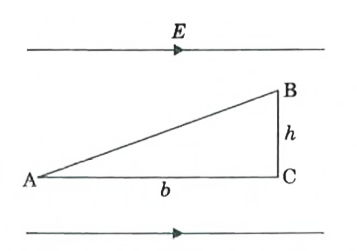Given that a current of 5.0 A passes along the branch from C to B is fig What is the voltage of points A,D,and G? 
a. VA=………… , b. VD=……………. c. VG=…………..
Video Solution
Text Solution
Givne I2−I3=5
in ADC,−7i1−4i3+2=0(i)
in FAEBC,2+3(i1−i3)−29−4i3=0
or −27+3i1−f7i3=0(ii)

(i)×3+(ii)×7givesi3=3A
Putting in Eq (i) we get i1=2A
Putting in Eq. (A) we get i2=2A
in ACB,VA−VB=2−(−3×4)orVA−0=14V
a. |VA|=14V,VA−VD=7×2=14
b. VD=14−14=0
VD−VG=6×(i1−i2)=6(2−2) or VG=0+VD
c. VG=0V
|
Topper's Solved these Questions
- ELECTRIC CURRENT AND CIRCUITBOOK - CENGAGE PHYSICSCHAPTER - ELECTRIC CURRENT AND CIRCUITEXERCISE - Subjective
29 Videos
- ELECTRIC CURRENT AND CIRCUITBOOK - CENGAGE PHYSICSCHAPTER - ELECTRIC CURRENT AND CIRCUITEXERCISE - Single Correct
72 Videos
- ELECTRIC CURRENT AND CIRCUITBOOK - CENGAGE PHYSICSCHAPTER - ELECTRIC CURRENT AND CIRCUITEXERCISE - Exercise 5.1
28 Videos
- ELECTRIC CURRENT & CIRCUITSBOOK - CENGAGE PHYSICSCHAPTER - ELECTRIC CURRENT & CIRCUITSEXERCISE - Kirchhoff s law and simple circuits
15 Videos
- ELECTRIC FLUX AND GAUSS LAWBOOK - CENGAGE PHYSICSCHAPTER - ELECTRIC FLUX AND GAUSS LAWEXERCISE - MCQ s
38 Videos
Similar Questions
Knowledge Check
The p.d (VB−VC between two point from C to B
Adoes not depend on the pathBdepends on the pathCdepends on test chargeDindependent of electric fieldIn the part of a circuit shown in fig. 5.266, the potential difference (VG−VH) between points G and H will be
 A0 VB15 VC7 VD3 V
A0 VB15 VC7 VD3 VIn the circuit element given here, if the potential at point B=VB=0, then the potentials of A and D are given as
 AVA=−1.5V,VD=+2VBVA=+1.5V,VD=+2VCVA=+1.5V,VD=+0.5VDVA=+1.5V,VD=−0.5V
AVA=−1.5V,VD=+2VBVA=+1.5V,VD=+2VCVA=+1.5V,VD=+0.5VDVA=+1.5V,VD=−0.5V
The V−I characteristic of a silicon diode is shown in the Fig. Calculate the resistance of the diode at
(a) ID=15mA and
(b) VD=−10V.
 .
.
View SolutionA uniform electric field E exists in a region of space. Refer to the given figure for the location of three points A, B and C.

Find: (a)VB−VA (b)VC−VA
View SolutionWhat comes next in the series?
B, D, H, N, ?
(A) V
(B) P
(C) S
(D) W
View SolutionIn Fig. 5.10, if AC=BD, then prove that AB=CD.

View SolutionIn the uniform electric field shown in figure, find :
a. VA−VD
b. VA−VC
c. VB−VD
d. VC−VD

View Solution

